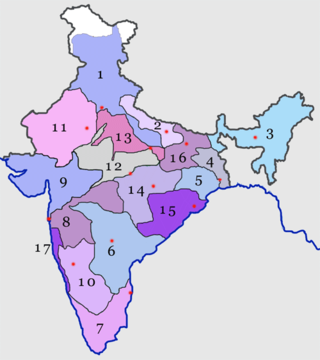
The Western Railway is one of the 19 zones of Indian Railways and is among the busiest railway networks in India, headquartered at Mumbai, Maharashtra. The major railway routes of Indian Railways which come under Western Railways are: Mumbai Central–Ratlam, Mumbai Central–Ahmedabad and Palanpur–Ahmedabad. The railway system is divided into six operating divisions: Ahmedabad, Vadodara, Rajkot, Bhavnagar, Ratlam, and Mumbai WR. Vadodara railway station, being the junction point for the Ahmedabad–Mumbai route and the Mumbai–Ratlam route towards New Delhi, is the busiest junction station in Western Railways and one of the busiest junctions of Indian Railways too, while Ahmedabad Division earns highest revenue followed by Mumbai Division and Vadodara Division. Surat railway station is one of the busiest railway station in Western Railway in non-junction category where more than 180 trains pass per day.
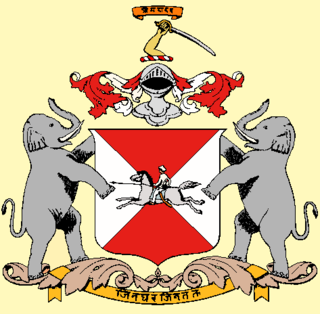
Gaekwads, a Hindu Maratha dynasty of the former Maratha Confederacy and its subsequent (erstwhile) princely state of Baroda in western India from the early 18th century until 1947. The ruling prince was known as the Maharaja Gaekwad of Baroda. With the city of Baroda (Vadodara) as its capital, during the British Raj its relations with the British were managed by the Baroda Residency. It was one of the largest and wealthiest princely states existing alongside British India, with wealth coming from the lucrative cotton business as well as rice, wheat and sugar production.

Dabhoi is a town and a municipality in the Vadodara district in the state of Gujarat, India.
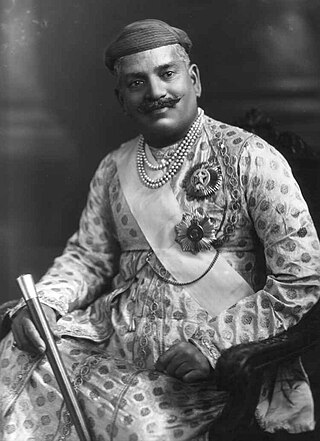
Sayajirao Gaekwad III was the Maharaja of Baroda State from 1875 to 1939, and is remembered for reforming much of his state during his rule. He belonged to the royal Gaekwad dynasty of the Marathas which ruled parts of present-day Gujarat.

The Bombay, Baroda and Central India Railway was a company incorporated in 1855 to undertake the task of constructing railway lines between Bombay to the erstwhile Baroda State, that became the present-day Baroda (Vadodara) city in western India. BB&CI completed the work in 1864. The first suburban railway in India was started by BB&CI, operating between Virar and Bombay Backbay station, a railway station in Bombay Backbay in April 1867.

Vadodara Junction railway station is the main station in the Indian city of Vadodara, Gujarat. Due to its strategic location, it is the fifth-busiest railway station in India in terms of frequency of trains after Kanpur Central, Vijayawada Junction, Delhi Junction, New Delhi, and Howrah,and busiest in Gujarat state as well as second important railway station in Gujarat after Ahmedabad Junction. It is also major stop on the Western Railway zone of Indian Railways. Around 340 trains start, end, or pass through the station weekly. This railway station is a junction point for rail lines from Mumbai, Delhi, Ahmedabad, Ektanagar (Kevadiya) and Chhota Udepur.
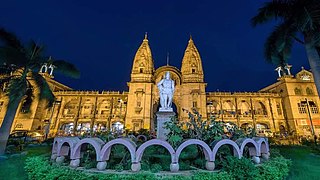
Khanderao market is a palatial commercial building located on Chamaraja Road in Vadodara, Gujarat, in western India. It was erected by Maharaja Sayajirao Gaekwad III in 1906–07 as a gift to the city municipality to mark the silver jubilee of his administration. The offices of the Vadodara Municipal Corporation are located here.

Cutch State Railway (CSR) was an isolated 2 ft 6 in (762 mm) narrow gauge railway in Cutch State, one of the princely states allied to Britain in India.

Bengal Provincial Railway was a 2 ft 6 in narrow-gauge railway from Tarakeswar to Magra, in Indian state of West Bengal.

Bhavnagar State Railway (BSR) was a metre gauge railway line in Bhavnagar State, now part of Gujarat in India.

Baroda State was kingdom within the Maratha Confederacy and later princely state in present-day Gujarat, ruled by the Gaekwad dynasty from its formation in 1721 until its accession to the newly formed Dominion of India in 1949. With the city of Baroda (Vadodara) as its capital, during the British Raj its relations with the British were managed by the Baroda Residency. The revenue of the state in 1901 was Rs. 13,661,000. Baroda formally acceded to the Dominion of India, on 1 May 1949, before which an interim government was formed in the state.
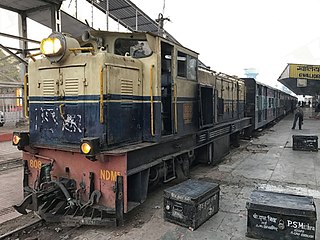
Gwalior Light Railway (GLR) or Maharaja Railway was a 2 ft narrow-gauge railway network in Gwalior. It was set up for Gwalior State during the times of British India. Until its closure in 2020, the railway was the longest 2 ft gauge railway in the world.
Asia has many narrow-gauge railways. The railways of Japan, Indonesia and the Philippines are predominantly 1,067 mm narrow gauge. Those in mainland Southeast Asia, which includes Vietnam, Cambodia, Laos, Thailand, Myanmar and Malaysia, are predominantly metre gauge. The proposed ASEAN Railway would be standard or dual gauge, using metre- and standard-gauge regional railway networks and linking Singapore through Malaysia, Thailand, Laos and Vietnam to China's standard-gauge rail network. In Western Asia, Jordan uses 1,050 mm narrow gauge.
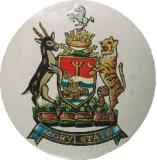
Morvi Railway (MR) was a 1,000 mm (3 ft 3+3⁄8 in) metre gauge line in the princely state of Morvi in Gujarat, India.

Shrimant Maharaja Sir Khanderao II Gaekwad, Sena Khas Khel Shamsher Bahadur, GCSI (1828–1870) was the Maharaja of Baroda State from 1856 to 1870.

The Ahmedabad–Mumbai main line or the Mumbai–Ahmedabad main line is a railway route on the Western Railway section of Indian Railways. It is one of the busiest railway routes of the Indian Railways and is fully electrified. The Western line of the Mumbai Suburban Railway operates on the southern part of this route.
Miyagam Karjan Junction railway station is a railway station in Vadodara district, Gujarat. Its code is MYG. It serves Karjan town. The station consists of 5 platforms. The platform is not well sheltered. It lacks many facilities including water and sanitation. Many Passenger, MEMU, Express and Superfast trains halt here.
Dabhoi Junction railway station is the main junction railway station in the Indian city of Dabhoi in Vadodara district, Gujarat, India. It falls under Western Railway's Vadodara railway division.

The Bilimora–Waghai section belongs to Mumbai WR division of Western Railway zone in Gujarat State of India.

















